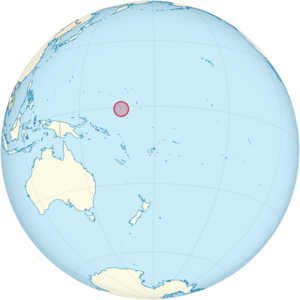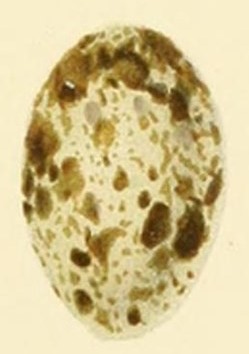Nauru reed warbler facts for kids
Quick facts for kids Nauru reed warbler |
|
|---|---|
| Conservation status | |
| Scientific classification | |
| Genus: |
Acrocephalus (bird)
|
| Species: |
rehsei
|
 |
|
| Location of Nauru | |
| Synonyms | |
|
|
The Nauru reed warbler (called itsirir in the Nauruan language) is a small passerine bird that lives only on the island of Nauru in the Pacific Ocean. It is one of only two native land birds that breed on Nauru. It is also the only passerine bird found there. This warbler is related to other Micronesian reed warblers. All of these birds developed from different groups that spread across the Pacific.
The Nauru reed warbler is a medium-sized bird. It has dark brown feathers on its back and creamy white feathers underneath. It also has a long, thin beak. It builds a cup-shaped nest and lays two or three white eggs. This bird mainly eats insects. Not much is known about its daily life or how it interacts with its environment. You can find it all over Nauru. The island has changed a lot recently because of phosphate mining. The Nauru reed warbler might be in danger from animals brought to the island and from losing its home. Because it lives in such a small area, it could also be hurt by sudden events like tropical cyclones.
Contents
About the Nauru Reed Warbler
Otto Finsch was the first scientist to visit Nauru. He stopped there for six hours on July 24, 1880. In his report from 1881, he first thought the warbler was the Caroline reed warbler. But by 1883, he realized it was a new species. He named it Calamoherpe rehsei. The name Calamoherpe is now known as another name for Acrocephalus. This is why the bird's scientific name is now Acrocephalus rehsei.
How it Got its Name
The name Acrocephalus comes from Greek words. Akros means "topmost" and kephale means "head". The name might refer to the bird's angular head shape. The old name Calamoherpe comes from Greek words meaning "reed" and "creeping thing". Finsch named the species after Ernst Rehse. He was a German bird expert and collector who traveled with Finsch. Since these first descriptions, not much more has been written about this bird. We still don't know many details about its life and habits.
Some experts once thought the Nauru reed warbler was a type of nightingale reed warbler. However, a DNA study in 2011 confirmed that it is its own separate species. It is also considered `monotypic`. This means there are no known subspecies or different types of Nauru reed warblers. People also call this bird Finsch's reed-warbler, Nauru warbler, or pleasant warbler.
Its Family Tree
A study in 2011 looked at the mitochondrial DNA of the Nauru reed warbler. It showed that this bird is closely related to the Australian reed warbler, the bokikokiko, the southern Marquesan reed warbler, and a species that is now extinct from Pagan Island. The closest relative to the Nauru reed warbler seems to be the extinct warbler from Pagan.
Warblers from Asia spread across the Pacific islands and eventually to Australia. This happened in a complex way. The Hawaiian islands were settled by warblers about 2.3 million years ago. Other islands were reached more recently, between 0.2 and 1.4 million years ago, or even later. The closest warblers to Nauru are the Carolinian reed warbler and the nightingale reed warbler.
What Does it Look Like?
The Nauru reed warbler is a medium-sized bird with warm colors. Its body is relatively light. All of its upper parts are dark brown. The feathers on its lower back and upper tail are a bit brighter than its tail and back. When its wing is closed, it is the same color as its back. The wing is short and rounded. It does not reach the start of the tail feathers, which makes the tail look long.
Its face does not have much contrast. Its cheeks, head, neck, chin, and throat are all a similar pale brown color. The area between its beak and eyes is dark brown. It has a pale, creamy "eyebrow" that goes from its beak to its ear feathers. These ear feathers are cinnamon-brown and get darker as they blend into the neck. Its beak is long, thin, and straight.
The underside of the bird is much lighter. It gets darker towards its bottom and under-tail feathers. Its chin is a dull cream color, blending into its throat, which then turns brownish. The middle of its chest is a dull brown-yellow, while the sides are reddish brown. The upper part of its beak is dark grey with pink edges. The lower part of its beak is pink, getting darker at the tip. Its legs and feet are dark grey. This bird can grow up to 15 centimetres (5.9 in) long. Its wingspan is about 6.7 to 7.2 centimetres (2.6 to 2.8 in).
Male and female Nauru reed warblers look the same. We don't know what the young birds look like. Since it's the only passerine bird on the island, it's easy to tell apart from any other bird. The Nauru reed warbler is a bit smaller than the Caroline reed warbler. The Caroline reed warbler is also lighter in color and has a more noticeable eyebrow. The nightingale reed warbler is much bigger. The Oriental reed warbler has duller colors and whiter underparts.
Where Does it Live?
The Nauru reed warbler lives only on the island of Nauru in the Pacific Ocean. It is one of only two native land birds that breed on the island. The other is the Micronesian pigeon. You can find the warbler all over the island. It does well in the scrubland areas that were once used for phosphate mining. It also lives in the remaining forest patches on the island's central plateau. It is most common in the forest areas found on the island's steep slopes. You can also easily see it in gardens and wild areas along the coast.
In 1881, Finsch said the species was very common. He called it "as common as the House-Sparrow in England." In 2008, biologist Donald Buden also found it widespread on the island.
Could it Have Lived Elsewhere?
These birds do not naturally leave Nauru. Banaba is the closest island. Even though it is similar to Nauru, it does not have any warblers. However, it's possible that Nauru reed warblers lived on other islands until recently. On the Marshall Islands, old stories talk about a small bird called annañ. This bird was thought to belong to the chiefs. No one has described what the bird looked like, but it was said to be butterfly-sized and to live among rocks on the shores of northwestern islands. Experts reported that the annañ became extinct around 1880. Some people think the annañ might have been a Nauru reed warbler. The annañ might have died out because of cats. Cats were brought to the Marshall Islands in 1817 to hunt rats. They then multiplied and were spread by locals as pets, after which they started to become wild.
Life and Habits
Building a Home
Nauru reed warbler nests are shaped like cups and are woven from grasses and twigs. They sometimes include Cassytha filiformis vines or Casuarina equisetifolia needles. The nests are tied to upright stems, which is typical for warblers. Buden reported that the warblers build their nests in trees and shrubs at a height of 2 to 8 m (6.6 to 26.2 ft). The species might also nest on the ground. Young birds in ground nests could be more easily caught by rats.
Eggs have been seen in December and July. One bird expert, A. Pearson, thought that the species might nest all year round. They usually lay two or three eggs. We don't know how long it takes for the eggs to hatch or for the young birds to leave the nest. Pearson saw nests lower down than Buden, finding them in bushes and undergrowth between 45 and 300 cm (18 and 118 in) from the ground. They especially liked forked branches of hibiscus and lime.
Its Song and Sounds
Buden noted that the birds were more vocal in December than in March and April. The song of the Nauru reed warbler has been described as similar to that of a song thrush, common blackbird, or willie wagtail. It sings both during the day and at night.
What Does it Eat?
Finsch said the warbler eats insects, mostly dragonflies. Six types of dragonflies have been seen on Nauru: Ischnura aurora, Anax guttatus, Diplacodes bipunctata, Pantala flavescens, Tholymis tillarga and Tramea transmarina. Buden did not see the birds eating dragonflies, but he did see them feeding in three different ways. Most often, the birds moved through trees and shrubs, catching prey on the leaves. Other birds were seen sitting close to the ground, darting down to catch prey, and then returning to their perch. In open areas, the birds moved across the ground, sometimes grabbing what they thought was prey. In coastal areas, they have been seen feeding in coconut trees.
Who Are Its Enemies?
Animals that might hunt birds on Nauru include wild cats and dogs. Also, the Polynesian rat and the tanezumi rat are potential threats. Wild cats and rats are especially dangerous for the Nauru reed warbler.
Is the Nauru Reed Warbler Safe?
The IUCN lists the Nauru reed warbler as "Vulnerable". This is because its very small home makes it sensitive to unexpected events. These can include cyclones or new predators being brought to the island. BirdLife International once thought there were between 10,000 and 20,000 Nauru reed warblers. But Buden's estimate in 2006 suggested there were about 5,000 birds of all ages. This led to a new estimate of 3,000 adult birds, which was confirmed in 2016.
Why it's Vulnerable
In 2001, people noticed that the removal of phosphate deposits on the island was reducing the plants. This was seen as a possible threat to the species. However, in 2008, Buden said that "habitat degradation and loss of native forest via mining operations has apparently had no major adverse effects on the population." Nauru reed warblers were seen to be common on the island. They were doing well in the scrubland left behind by mining.
Protecting the Warbler
Unlike other birds on the island, the Nauru reed warbler is not hunted. It is protected under Nauru's Wild Birds Preservation Ordinance 1937. For conservation, the IUCN suggests regularly counting the birds. They also recommend starting a monitoring program by training local people. They also proposed making more people aware of the bird to help protect it.
See also
- List of birds of Nauru




